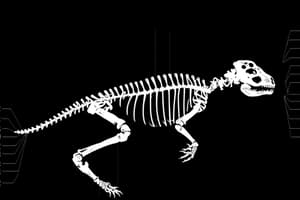Podcast
Questions and Answers
Which of the following correctly defines taxonomy?
Which of the following correctly defines taxonomy?
- The study of diversity and differentiation of organisms
- Discovering, describing, and naming organisms (correct)
- Classification by evolutionary relationships
- A scientific discipline that uses nucleic acids to infer relationships
What is systematics?
What is systematics?
Study of diversity and differentiation of organisms and relationships between organisms.
Define phylogeny.
Define phylogeny.
Classification by evolutionary relationships.
Why is it important to distinguish between homology and analogy?
Why is it important to distinguish between homology and analogy?
Explain why bird and bat wings are homologous but analogous.
Explain why bird and bat wings are homologous but analogous.
List some problems associated with using common names.
List some problems associated with using common names.
What is binomial nomenclature?
What is binomial nomenclature?
Describe hierarchical classification.
Describe hierarchical classification.
List the major taxonomic categories from most to least inclusive.
List the major taxonomic categories from most to least inclusive.
Define a clade.
Define a clade.
Which of the following is a characteristic of a monophyletic group?
Which of the following is a characteristic of a monophyletic group?
Differentiate between shared primitive characters and shared derived characters.
Differentiate between shared primitive characters and shared derived characters.
How can shared derived characters be used to construct a phylogeny diagram?
How can shared derived characters be used to construct a phylogeny diagram?
How does outgroup comparison help distinguish between ancestral and derived characters?
How does outgroup comparison help distinguish between ancestral and derived characters?
What is the principle of maximum parsimony?
What is the principle of maximum parsimony?
Explain maximum likelihood in phylogeny reconstruction.
Explain maximum likelihood in phylogeny reconstruction.
Why does a phylogenetic diagram represent a hypothesis?
Why does a phylogenetic diagram represent a hypothesis?
Differentiate between orthologous and paralogous genes.
Differentiate between orthologous and paralogous genes.
Explain how gene duplication has led to families of paralogous genes.
Explain how gene duplication has led to families of paralogous genes.
What is cladistics?
What is cladistics?
What is a cladogram?
What is a cladogram?
What is homoplasy?
What is homoplasy?
Define ingroup.
Define ingroup.
What is an outgroup?
What is an outgroup?
Define molecular systematics.
Define molecular systematics.
What is a phylogenetic tree?
What is a phylogenetic tree?
What is a taxon?
What is a taxon?
Flashcards are hidden until you start studying
Study Notes
Taxonomy, Systematics, and Phylogeny
- Taxonomy: Involves discovering, describing, and naming organisms (nomenclature).
- Systematics: Examines organism diversity, differentiation, and relationships.
- Phylogeny: Focuses on classifying organisms based on evolutionary relationships.
Homology vs. Analogy
- Homology: Similarities stemming from a shared ancestry; indicates evolutionary connections.
- Analogy: Similar traits due to convergent evolution, not shared ancestry.
Wings of Birds and Bats
- Homologous: Both originated from a common forelimb ancestor but could not fly.
- Analogous: Adapted similar structures for flight through different evolutionary paths.
Common Names Issues
- Older terms can vary with language and region.
- Common names typically developed for familiar species only.
- A single species may have multiple common names, creating confusion.
Linnaean System Characteristics
- Binomial Nomenclature: Two-part naming format using genus and species, italicized with specific capitalization rules (e.g., Homo sapiens).
- Hierarchical Classification: Organisms grouped into broad categories, with increasing specificity (e.g., Leopard - Panthera pardus belongs to Panthera genus).
Taxonomic Hierarchy
- Domains: Most inclusive category.
- Animal Kingdom: Includes Animalia.
- Phylum: Chordata.
- Class: Mammalia.
- Order: Primates.
- Family: Hominidae.
- Genus: Homo.
- Species: H. sapiens.
Clades and Groupings
- Clade: A group of species including an ancestor and all descendants.
- Monophyletic Group: Ancestral species and all its descendants, recognized as legitimate taxa.
- Paraphyletic Group: Includes an ancestor but not all descendants.
- Polyphyletic Group: Lacks the common ancestor of its members.
Character Types in Phylogeny
- Shared Primitive Characters: Traits common to a clade but originating from an ancestor outside the clade.
- Shared Derived Characters: Unique evolutionary novelties specific to a clade.
Constructing Phylogeny Diagrams
- Shared derived characters identify clades and depict evolutionary relationships.
Outgroup Comparison
- Compares outgroups to identify derived characters at branch points in evolution.
Phylogenetic Reconstruction Principles
- Maximum Parsimony: Seeks the simplest explanation with the fewest evolutionary events.
- Maximum Likelihood: Reflects the most probable sequence of events based on DNA change rules.
Phylogenetic Diagrams
- Represent hypotheses regarding evolutionary relationships among species.
Gene Types
- Orthologous Genes: Found in different species due to speciation.
- Paralogous Genes: Found within the same genome due to gene duplication.
Gene Duplication Impact
- Increases gene number, allowing diversification of paralogous genes within a clade.
Cladistics and Cladogram
- Cladistics: Classifying organisms based on shared measurable characteristics.
- Cladogram: A branching diagram showing cladistic relationships among species.
Homoplasy
- Character shared by species not present in their common ancestor, often through convergence (e.g., independent evolution of eyes).
Ingroup vs. Outgroup
- Ingroup: A small group with shared interests or characteristics.
- Outgroup: Organisms outside the group being studied for evolutionary relationships.
Molecular Systematics
- Utilizes nucleic acids or molecules to infer species' evolutionary relationships.
Phylogenetic Tree
- A diagram depicting lines of descent among species or genes from a common ancestor.
Taxon Definition
- Any taxonomic group, regardless of rank, such as species, family, or class.
Studying That Suits You
Use AI to generate personalized quizzes and flashcards to suit your learning preferences.



